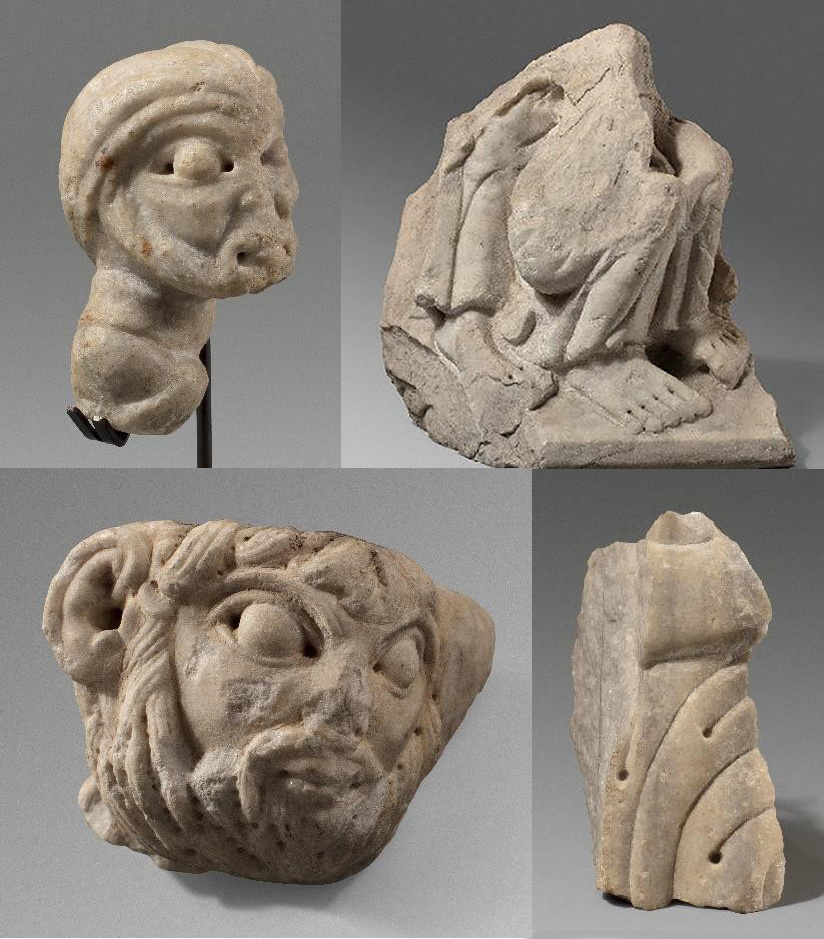Four sculptural fragments by the Master of Cabestany, from the monastery of Sant Pere de Rodes, incorporated in the collections of the Museu Nacional d'Art de Catalunya
Four sculptural fragments by the Master of Cabestany, from the monastery of Sant Pere de Rodes, incorporated in the collections of the Museu Nacional d'Art de Catalunya
The Department of Culture has acquired two heads and two other fragments of characters attributed to the Master of Cabestany and his workshop, to form part of the National Collection and enrich the Romanesque rooms of the MNAC. The set of pieces has been acquired by the Generalitat for an amount of 250,000 Euros from the galleries Artur Ramon Art, Palau Antiguitats and Clavell & Morgades Antiguitats. These pieces come from the portal of the monastery of Sant Pere de Rodes, which was sculpted by the Master of Cabestany in the 12th century, under the patronage of the Viscounts of Peralada.
The Museu Nacional d’Art de Catalunya (MNAC) has incorporated into its collections four sculptural fragments from the monastery of Sant Pere de Rodes (Alt Empordà), attributed to the Master of Cabestany and his workshop.
The pieces have been acquired by the Department of Culture for an amount of 250,000 Euros from the galleries Artur Ramon Art, Palau Antiguitats and Clavell & Morgades Antiguitats, and become part of the National Collection which, every year, is enlarged by means of the acquisitions policy provided for by current legislation on cultural heritage and the sectoral promotion plans of the Generalitat de Catalunya, which have the function of promoting the heritage of various artistic disciplines such as the Integral Visual Arts Plan, the National Photography Plan and Comic and Illustration Commission.
The four sculptural fragments have been examined on different occasions by the Museu Nacional’s specialist technicians. Only one of the pieces had been exhibited and published before, while the other three are almost unpublished and will be exhibited for the first time to the general public. They are made of white marble and included human figures and historical scenes dated between 1160 and 1163: it is a head (7 x 11.5 x 10 cm), a second head with part of the right shoulder (12 x 7.5 x 8 cm), a fragment of the lower part of a character belonging to a New Testament scene of the healing of a woman (25 x 27 x 9 cm) and a small fragment of clothing (12 x 6 x 10cm).
These pieces would have been part of the biblical cycles that decorated the large portal of the church of Sant Pere de Rodes, built in the second third of the 12th century and destroyed during the first third of the 19th century. With unanimity, it has been attributed to the anonymous sculptor known as the Master of Cabestany, a genius artist comparable to what the Master of Sant Climent de Taüll represents in painting. Various public and private institutions in Catalonia and abroad conserve some of the reliefs and fragments that have survived, and which have been the subject of interest by Catalan and international specialists. Despite their fragmented state, the four reliefs are a faithful reflection of the great technical quality and sculptural strength of their author. In addition, they offer a sufficiently eloquent range of the monumental scope of the above-mentioned Empordà portal and its historic subject matter.
The study of these pieces has made it possible to carry out new research on the Master of Cabestany and the portal of Sant Pere de Rodes, which will be published in the form of a book (El Mestre de Cabestany. Espurnes de marbre – The Master of Cabestany, Flakes of Marble 2023), where a new hypothetical reconstruction will be made known about the destroyed doorway, as well as a new interpretation about the function and context of this masterpiece.
The incorporation of the pieces into the Museu Nacional will contribute to filling the gap that currently exists regarding the sculpture of the Master of Cabestany, one of the most original and prolific Romanesque artists, given that he was active in Catalonia, Navarre, Roussillon, Occitania and Tuscany. Despite being an anonymous artist, he is one of the most unique and studied figures in Romanesque sculpture, with an international bibliography. With this acquisition, it will be possible to explain at the Museu Nacional another of the masterpieces of medieval Catalan art through a space dedicated to the monastery of Sant Pere de Rodes, alongside other centres of stone sculpture such as Ripoll and, above all, of the large groups of mural paintings.
The portal of the Master of Cabestany
In the twelfth century, under the patronage of the Viscounts of Peralada, the portal of the church was sculpted, currently missing due to looting. The only remains that remain in their original location are on the two lower sides of the main door. They are two fragments of marble, sculpted with plant motifs, fantastic animals and human heads. The rest of the portal was dispersed and many items ended up in the hands of collectors.
Despite everything, the location of some fragments preserved or known through photographs has allowed them to be studied and different reconstructions proposed. The pieces show that reliefs of different sizes were worked on, both on stone and on reused Roman marbles. The portal was characterised by abundant figuration, which represented evangelical passages, with the characteristics typical of the work of the Master of Cabestany, such as the use of the drill technique and Roman models in the composition that the master learned from the observation of early Christian sarcophagi.
Millennium of Sant Pere de Rodes
This acquisition comes in the year in which the Millennium is celebrated of the consecration of the church of the monastery of Sant Pere de Rodes, where the sculptural pieces originate from.
On 5th October, 1022, the church of the monastery of Sant Pere de Rodes was consecrated, which today is a world benchmark for its architecture and originality.
The consecration led to the consolidation of the domains of the monastery at the beginning of the 11th century and the beginning of a long period of splendor, which today we see reflected in the set of constructions of the monument and which have made it one of the most beloved and admired of Catalonia.
To commemorate these thousand years of the consecration of Sant Pere de Rodes, the Catalan Cultural Heritage Agency of the Department of Culture has held various events and celebrations that will last until May 2023 and which can be consulted at the cultural heritage website, Patrimoni Cultural.













